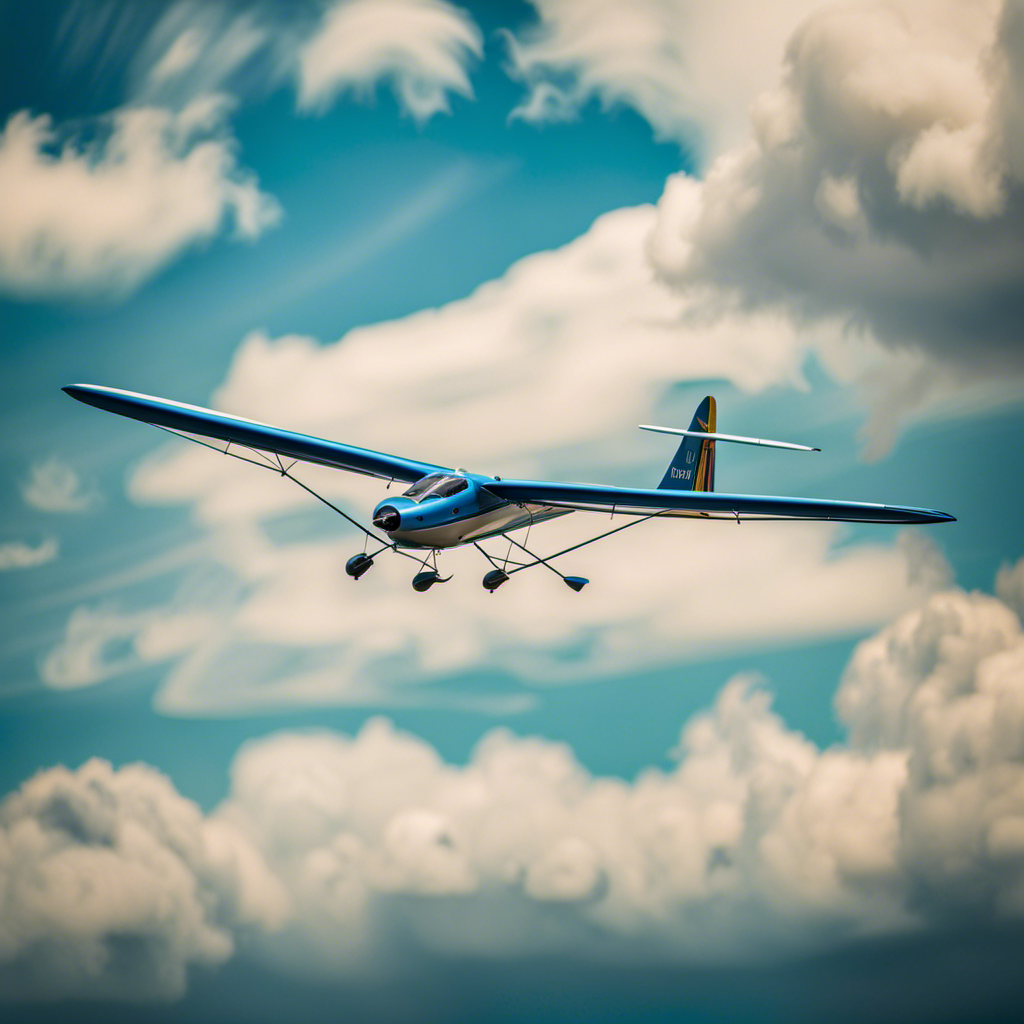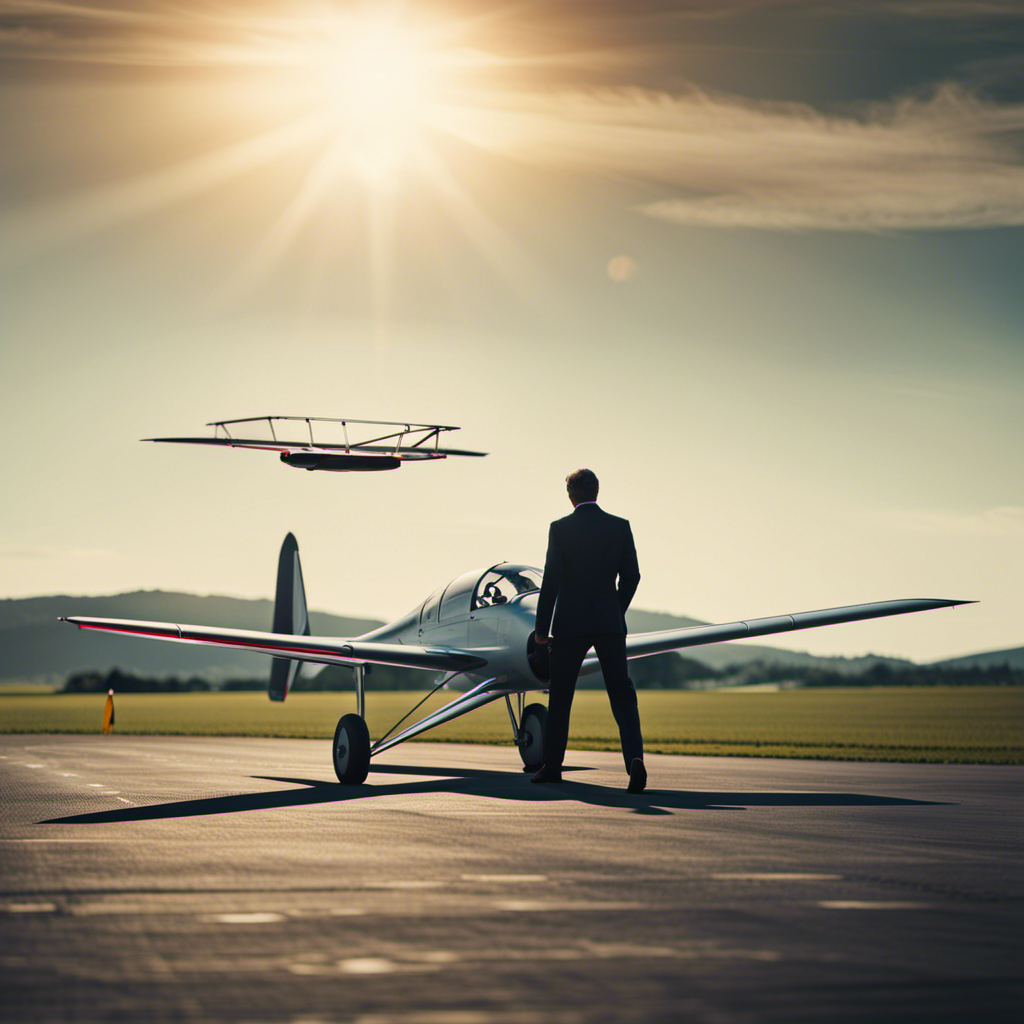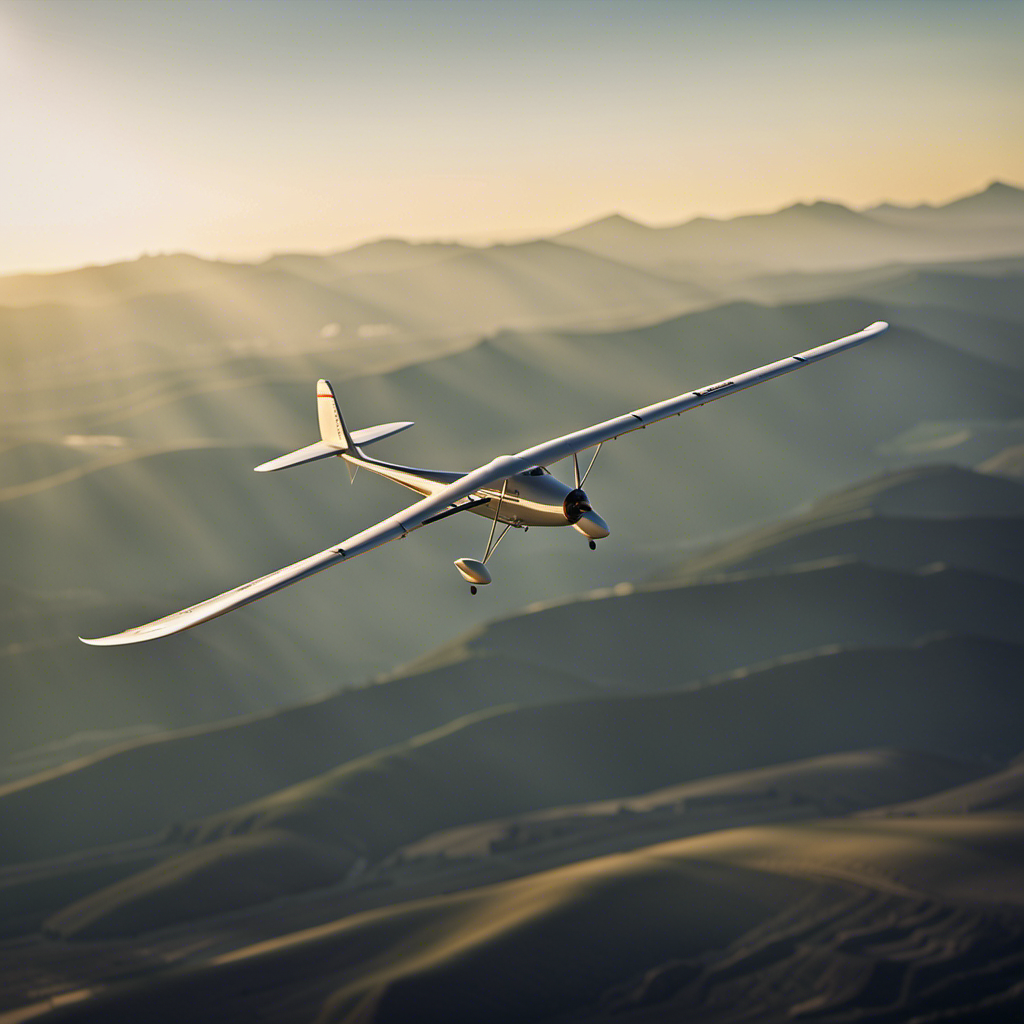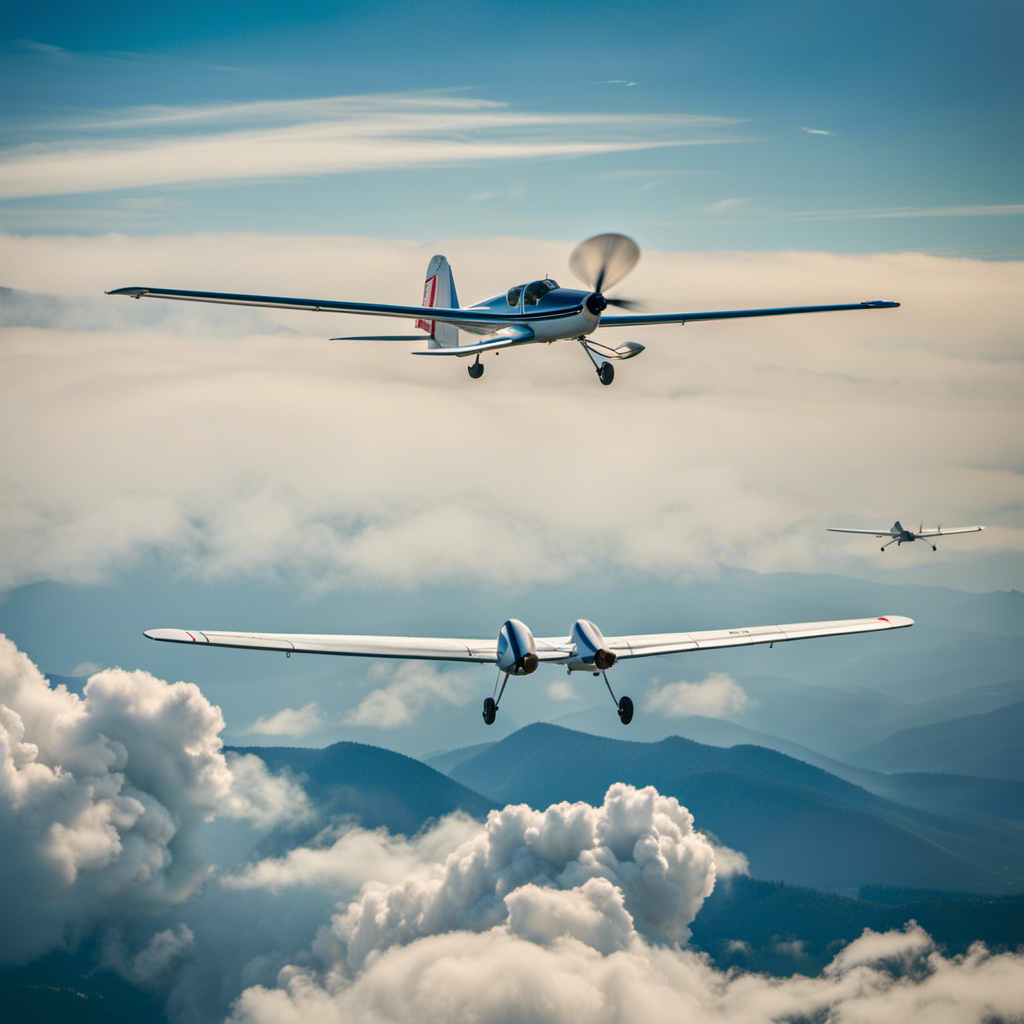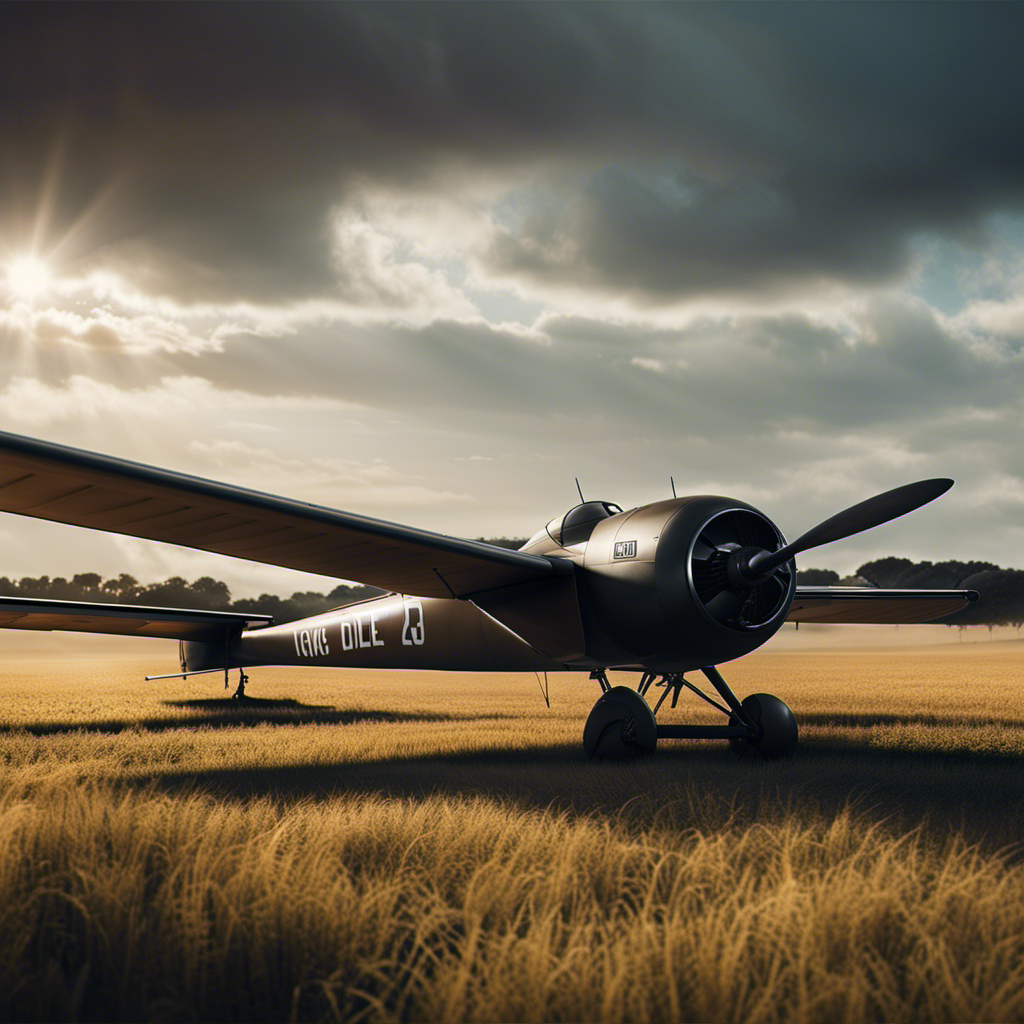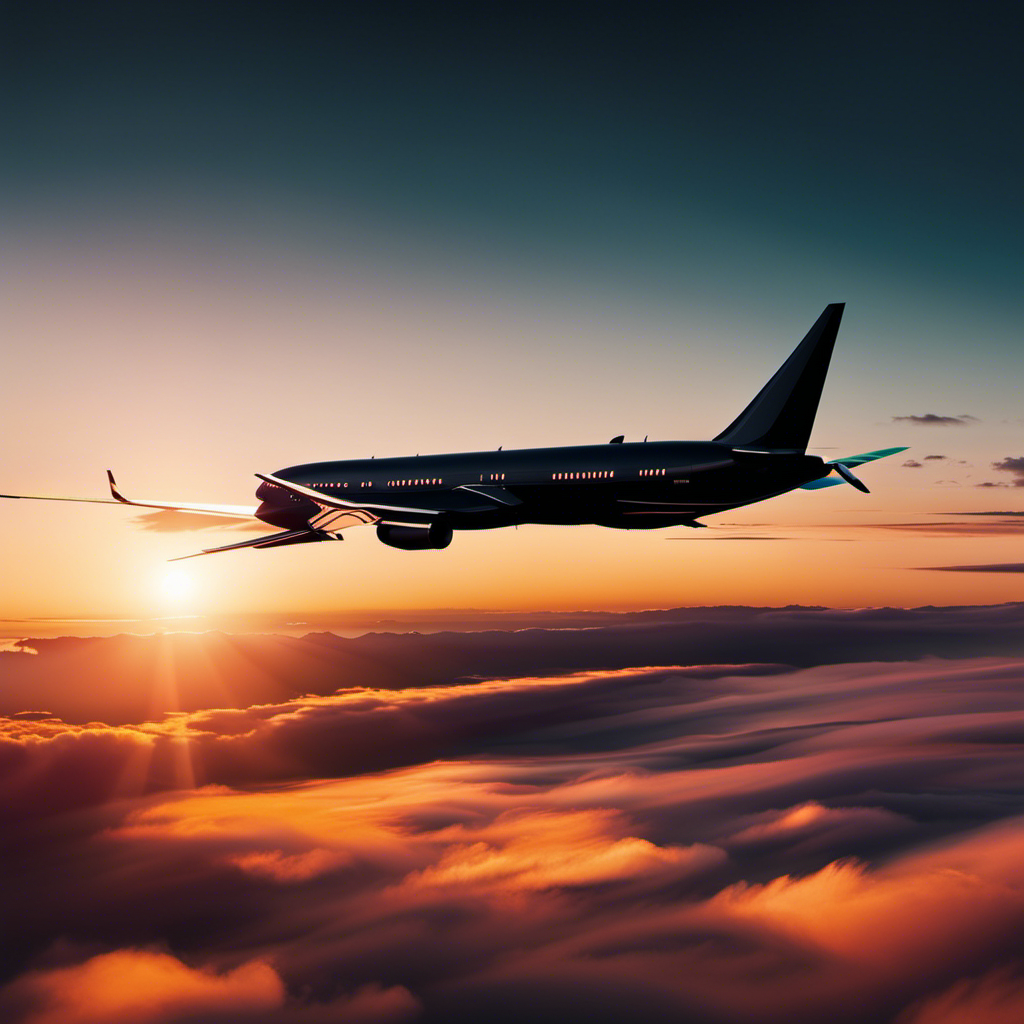Were you aware that gliders have the ability to reach altitudes of up to 40,000 feet without relying on an engine? It’s truly remarkable how these aircraft can soar through the air, solely depending on natural forces.
In this article, I will explore the fascinating principles of aerodynamics that allow gliders to take flight. We’ll delve into the various types of gliders, the techniques used to launch them, and the instruments that help pilots navigate the skies.
Get ready to uncover the secrets behind the art of gliding.
Key Takeaways
- Gliders rely on aerodynamics and the shape of their wings to generate lift and stay in the air without an engine.
- There are different types of gliders, including standard, high-performance, and motorized gliders, each designed for specific purposes and conditions.
- Gliders can be launched using winch launching or aerotow launching techniques, depending on the availability of space and runway access.
- Gliders utilize various instruments, such as altimeters, variometers, airspeed indicators, and compasses, for navigation, altitude control, and optimizing thermal-seeking strategies.
The Principles of Aerodynamics
The principles of aerodynamics explain how gliders stay in the air without an engine. Aerodynamics is the study of how air flows around objects and how these objects interact with that flow. When it comes to gliders, the main principle at play is lift.
Lift is the force that opposes gravity and keeps the glider airborne. It is generated by the wings of the glider, which are designed in a specific shape to create lift. As the glider moves through the air, the shape of the wings creates a pressure difference, with lower pressure on top and higher pressure on the bottom. This pressure difference generates lift, allowing the glider to stay in the air.
Understanding the principles of aerodynamics is crucial in designing and operating gliders effectively.
Now, let’s explore the different types of gliders and how they utilize these principles.
Types of Gliders
To learn about different types of gliders, you’ll want to start by researching their various designs and features. Gliders come in a range of designs, each tailored to specific purposes and conditions. There are standard gliders, which are versatile and commonly used in glider competitions. These gliders have a moderate wingspan and are designed for both performance and stability.
On the other hand, there are high-performance gliders, built for advanced pilots seeking speed and maneuverability. These gliders have longer wingspans, sleeker designs, and are often used in advanced glider competitions. Additionally, there are motorized gliders, equipped with engines for extended flight durations.
Understanding the different glider designs is essential to choosing the right one for your needs. Now, let’s explore the various launching techniques used to get gliders into the air.
Launching Techniques
Let’s now delve into the different ways gliders are launched into the air. There are two primary methods used for launching gliders: winch launching and aerotow launching.
-
Winch launching: This method involves using a powerful winch to rapidly reel in a cable attached to the glider. As the winch pulls the glider, it gains speed and lift, allowing it to take off. Winch launching is commonly used in areas with limited space or where there is no access to a runway.
-
Aerotow launching: In this method, the glider is attached to a powered aircraft called a tow plane via a towline. The tow plane takes off and pulls the glider along, gradually gaining altitude. Once the desired altitude is reached, the glider releases the towline and continues soaring independently.
Transitioning into the subsequent section about ‘gliding instruments,’ it is important for glider pilots to have precise instruments to aid in their flights.
Gliding Instruments
Transitioning into the subsequent section about ‘gliding instruments,’ it’s important for glider pilots to have precise instruments to aid in their flights. Gliding techniques require careful control of altitude, and having accurate instruments is essential for achieving this.
One crucial instrument is the altimeter, which provides the pilot with real-time information about their current altitude. This helps them maintain the desired height during the glide.
Another important instrument is the variometer, which indicates the rate of climb or descent. By monitoring the variometer, pilots can adjust their gliding techniques to maximize lift and minimize sinking air.
Additionally, glider pilots rely on the airspeed indicator and the compass for navigation and speed control. These instruments enable precise altitude control and ensure safe and efficient gliding.
Transitioning into the subsequent section about ‘finding and using thermals,’ pilots must be able to utilize these instruments effectively to identify and exploit rising air currents.
Finding and Using Thermals
Take advantage of the altimeter and variometer to locate and harness thermals effectively while gliding. Finding thermals is crucial for maintaining altitude and extending flight time.
The altimeter provides information on the glider’s current altitude, allowing the pilot to identify potential thermal sources such as cumulus clouds or areas of increased ground heating. The variometer, on the other hand, measures the rate of climb or descent, indicating the presence and strength of a thermal.
Once a thermal is detected, the pilot can exploit it by circling within the rising air mass, gradually gaining altitude. By actively monitoring the altimeter and variometer, glider pilots can optimize their thermal-seeking strategies and navigate the sky with precision.
Transitioning into ridge soaring, pilots can also utilize the altimeter and variometer to take advantage of the updrafts created by the wind hitting a ridge.
Ridge Soaring
When it comes to ridge soaring, understanding wind patterns is crucial. By utilizing wind patterns, glider pilots can effectively harness the power of the wind to maintain altitude and even gain speed.
Techniques for flying along ridges involve skillfully maneuvering the glider to take advantage of the uplift created by the wind as it interacts with the terrain. However, safety considerations must always be taken into account, such as avoiding turbulence and maintaining a safe distance from the ridge to prevent accidents.
Utilizing Wind Patterns
To get your glider into the air, you can follow wind patterns to harness the power of the wind. Wind patterns play a crucial role in glider design and flying techniques. Here are three important factors to consider when utilizing wind patterns:
-
Wind direction: Understanding the prevailing wind direction is key to successful glider flight. By analyzing wind patterns, you can determine the best launch direction and optimize your flight path.
-
Wind speed: The speed of the wind affects the amount of lift generated by the glider. Higher wind speeds provide more lift, allowing the glider to stay airborne for longer durations.
-
Thermals: Thermal updrafts are pockets of warm air that can significantly increase the glider’s altitude. By locating and riding thermals, you can gain altitude and extend your flight time.
Techniques for Flying Along Ridges
Use the natural contours of the ridge to your advantage, as they can provide lift and help you maintain altitude during your glider flight.
Ridge flying is a technique that harnesses the power of the wind as it flows over the ridge. As the wind encounters the ridge, it is forced upward, resulting in a phenomenon called ridge lift.
To effectively utilize ridge lift, it is important to position your glider in the upwind side of the ridge. By flying close to the ridge, you can take advantage of the rising air and gain altitude. The key is to maintain a constant speed and angle relative to the ridge, ensuring a steady source of ridge lift.
However, safety considerations must also be taken into account when ridge flying, as flying too close to the ridge can be hazardous and requires proper training and experience to navigate safely.
Safety Considerations
Transitioning from the techniques used for flying along ridges, we now delve into the safety considerations that are paramount in glider operations.
As a pilot, I understand the importance of being prepared for any unexpected situations that may arise during a flight. One such situation is the need for an emergency landing. Gliders lack an engine, so pilots must be trained to identify suitable landing spots and execute safe landings in case of an emergency. This training includes techniques for assessing the terrain, wind conditions, and obstacles to ensure a successful and safe landing.
Additionally, pilots must be familiar with emergency procedures and communication protocols to quickly and effectively deal with any unforeseen circumstances. Safety is a top priority in glider flying, and proper pilot training ensures that we are well-equipped to handle any emergencies that may arise.
Transitioning into the subsequent section about ‘wave soaring,’ we explore another method by which gliders gain altitude without the use of thermals.
Wave Soaring
Understanding Mountain Wave is crucial for glider pilots who want to take advantage of this powerful phenomenon. Mountain Wave refers to the oscillating vertical motion of air caused by the interaction between wind and mountains.
Riding the Wave involves skillfully maneuvering the glider in the updrafts and downdrafts of the wave, allowing the aircraft to gain altitude and cover long distances.
However, there are also challenges and risks associated with Wave Soaring, such as turbulence, rotor effects, and the potential for wave-induced structural damage to the glider.
Understanding Mountain Wave
The glider can’t fly without riding the mountain wave. Understanding mountain wave dynamics is crucial for glider pilots seeking to harness wave lift mechanisms. Here are some key points to consider:
- Mountain wave occurs when a stable layer of air flows over a mountain range. The air is forced to rise, creating wave-like patterns in the atmosphere.
- These waves can extend for hundreds of miles downwind of the mountain range. Wave lift occurs when the glider enters an updraft within the wave.
- Pilots can reach incredible altitudes by continuously riding these waves.
Riding the Wave
Riding the mountain wave requires skilled maneuvering and an awareness of the ever-changing dynamics of the wave. As a glider pilot, mastering the riding technique is crucial to successfully navigate these complex atmospheric conditions. Understanding the wave dynamics is essential in order to effectively utilize the energy provided by the mountain wave.
To ride the wave, pilots must position their gliders in the most favorable areas of lift and descent. This requires careful analysis of wind patterns, terrain features, and the shape of the wave. The table below provides a visual representation of the different riding techniques used in various wave conditions:
| Wave Condition | Riding Technique |
|---|---|
| Steady wave | Ridge-soaring |
| Rotors present | Wave-hopping |
| Wave gaps | Wave-jumping |
By adapting their flying techniques to suit the specific wave dynamics, pilots can optimize their altitude gain and maintain a stable flight path. This ensures a smooth and efficient ride on the mountain wave.
Transitioning into the subsequent section about ‘challenges and risks,’ pilots must also be aware of the potential hazards and complexities that come with riding the mountain wave.
Challenges and Risks
Transitioning into the subsequent section, pilots must be aware of the challenges and risks that come with riding the mountain wave.
The mountain wave is a powerful updraft that can propel gliders to great heights, but it also presents a unique set of challenges. One of the main challenges is turbulence, which can be intense and unpredictable. Pilots must constantly adjust their flight controls to maintain stability and avoid losing control of the aircraft.
Additionally, the mountain wave can create strong wind shears, making it difficult to maintain a steady course. These challenges, combined with the risks of flying at high altitudes and in remote areas, require pilots to be highly skilled and prepared for any situation.
Transitioning into the subsequent section, cross-country flying requires a different set of skills and strategies.
Cross-Country Flying
When it comes to cross-country flying, there are three key points to keep in mind.
Firstly, planning a route involves considering factors such as weather conditions, airspace restrictions, and available landing sites along the way.
Secondly, navigating with GPS is essential for accurate and efficient flight paths. It allows pilots to track their location, distance, and heading in real-time.
However, it’s important to be aware of potential pitfalls. These include relying too heavily on technology or failing to adapt to changing conditions. These pitfalls can compromise the success and safety of the flight.
Planning a Route
Before taking off, I map out my route and carefully plan my flight path. Route planning is crucial for a successful cross-country flight in a glider.
First, I gather all the necessary information, including the distance, airspace restrictions, and potential landing sites along the way. I also take into account weather forecasting to avoid unfavorable conditions such as strong headwinds or thunderstorms. By analyzing weather patterns, I can identify areas of lift and plan my flight to maximize the time spent soaring.
Additionally, I consider the available landmarks and waypoints that can help me navigate accurately. Planning a route requires attention to detail and a thorough understanding of the weather conditions to ensure a safe and efficient flight.
Now, let’s move on to navigating with GPS.
Navigating with GPS
To navigate with GPS, you’ll rely on satellite signals to determine your precise location and track your progress during the flight. GPS accuracy is crucial for safe and efficient navigation.
Here are three key factors that affect GPS accuracy:
-
Satellite visibility: The more satellites your GPS receiver can ‘see,’ the more accurate your position will be. Obstructions like tall buildings or dense foliage can interfere with satellite signals and reduce accuracy.
-
Signal multipath: When GPS signals bounce off surfaces like buildings or mountains before reaching your receiver, it can cause errors in position calculation. To minimize this, ensure a clear line of sight to the sky.
-
GPS interference: Electronic devices or structures emitting radio frequency signals can interfere with GPS reception and impact accuracy. Avoid placing your GPS receiver near such devices or structures.
Maintaining GPS accuracy is crucial for successful navigation, but there are pitfalls to avoid to ensure reliable tracking and positioning during your flight.
Pitfalls to Avoid
One common pitfall to avoid when navigating with GPS is placing your receiver near electronic devices or structures emitting radio frequency signals. This can interfere with GPS reception and impact accuracy.
Another important pitfall to avoid when flying a glider is encountering turbulence. Turbulence can be caused by a variety of factors such as weather conditions, terrain, or even other aircraft. To avoid turbulence, it is crucial to carefully plan your flight path, taking into account weather forecasts and any potential areas of turbulence.
Additionally, regular glider maintenance is essential to ensure safe and efficient flight. This includes inspecting the glider for any signs of wear and tear, checking the control surfaces and cables, and performing routine maintenance tasks such as lubricating moving parts.
Safety Precautions
When it comes to ensuring safety in glider flying, there are several key points to consider.
First and foremost, conducting thorough pre-flight inspections is essential. This involves carefully examining the glider’s structure, control surfaces, and systems to identify any potential issues before taking to the air.
Additionally, being well-versed in emergency procedures is crucial for handling unexpected situations that may arise during flight. This includes knowing how to react to scenarios such as loss of control, structural failure, or inclement weather conditions.
Speaking of weather, understanding and considering the current and forecasted weather conditions is vital for safe glider operations. This involves evaluating factors such as wind speed and direction, cloud formations, and atmospheric stability to make informed decisions about when and where to fly.
Pre-flight Inspections
Inspecting the aircraft’s control surfaces ensures they are properly aligned and functioning before takeoff. As a pilot, I always follow a pre-flight checklist to ensure all necessary equipment inspections are completed. Here are the key steps I take during the pre-flight inspection:
-
Control Surfaces: I visually inspect the control surfaces, such as the ailerons, elevator, and rudder, to ensure they are free of any damage or obstructions. I also check that they move smoothly and are properly aligned.
-
Flight Instruments: I verify that all flight instruments, including the altimeter, airspeed indicator, and variometer, are functioning correctly and have accurate readings.
-
Safety Equipment: I ensure that all safety equipment, such as the parachute, emergency locator transmitter, and fire extinguisher, are present and in good working condition.
-
Exterior Inspection: I conduct a thorough inspection of the exterior of the glider, checking for any signs of damage, loose components, or leaks.
By diligently performing these pre-flight inspections, I can ensure that the glider is in optimal condition for a safe flight.
Now, let’s move on to the next crucial aspect of glider safety: emergency procedures.
Emergency Procedures
Make sure you familiarize yourself with the emergency procedures to ensure your safety in any unforeseen circumstances.
In the event of an emergency landing, the first step is to remain calm and assess the situation.
If a safe landing cannot be guaranteed, it may be necessary to deploy the parachute. To deploy the parachute, reach for the handle located on the side of the cockpit and pull it firmly towards you. This action will release the parachute from its container and initiate its deployment.
Once the parachute is fully deployed, it will slow down the descent of the glider, allowing for a safer landing.
It is important to practice these procedures regularly to ensure a quick and efficient response in emergency situations.
Now, let’s move on to the next section: weather considerations.
Weather Considerations
Before taking off, make sure you check the weather conditions to ensure a safe flight. Weather patterns and atmospheric conditions play a crucial role in glider operations. Here are three important factors to consider:
-
Wind: Assess the wind direction and speed to determine the best takeoff and landing strategies. Crosswinds can affect the glider’s control, so it’s important to be aware of the wind’s impact on the flight path.
-
Clouds: Study the cloud formations as they can indicate potential thermals or areas of lift. Cumulus clouds, for example, often form above areas of rising warm air, which gliders can use to gain altitude.
-
Visibility: Good visibility is essential for safe gliding. Poor visibility due to fog, rain, or low clouds can make it difficult to navigate and land safely.
Considering these weather factors will help ensure a successful and enjoyable gliding experience. Now, let’s dive into the sheer joy of gliding without delay.
The Joy of Gliding
Once you’re in the air, gliding gives you a sense of pure joy and freedom.
Gliding techniques are essential for achieving maximum efficiency and control during a flight. To maintain altitude and prolong the glide, pilots utilize techniques like thermal soaring, ridge soaring, and wave soaring.
Thermal soaring involves circling within rising columns of warm air, while ridge soaring uses the wind deflected by a ridge to gain lift. Wave soaring occurs when strong winds encounter a mountain range and create standing waves of rising air.
These techniques are not only used for recreational flying but also play a crucial role in gliding competitions. Gliding competitions test a pilot’s skill in utilizing these techniques to navigate through various tasks, such as flying long distances or completing specific flight patterns.
The sense of joy and freedom experienced during gliding is heightened when competing against fellow pilots, aiming for the top spot on the leaderboard.
Frequently Asked Questions
Are gliders powered by engines?
No, gliders are not powered by engines. They rely on unpowered flight and their aerodynamic design to stay in the air. Gliders are launched using various methods such as a tow plane or a winch.
How long can a glider stay in the air?
A glider’s endurance in the air depends on various factors, such as weather conditions and the pilot’s expertise in utilizing glider soaring techniques. By exploiting thermal uplifts and ridge lift, a glider can stay in the air for several hours, even up to a full day.
Can gliders fly at night?
Is night flying safe? Yes, it can be with proper training and equipment. Advantages of flying gliders at night include calmer air, reduced thermal activity, and the opportunity to navigate by stars and moonlight.
What is the maximum altitude a glider can reach?
The maximum altitude a glider can reach is determined by its performance capabilities. Gliders can achieve altitudes of up to 50,000 feet or more, depending on factors such as weather conditions, thermals, and the glider’s design and aerodynamic efficiency.
How fast can gliders fly?
Gliders can reach impressive maximum speeds due to their sleek and aerodynamic design. With careful engineering, they can soar through the air at incredible velocities, harnessing the power of wind currents to achieve remarkable performance.
Conclusion
In conclusion, gliding is a truly fascinating and exhilarating sport. It combines the principles of aerodynamics with the thrill of soaring through the sky.
From the various types of gliders to the different launching techniques and gliding instruments, there is so much to learn and master.
And let’s not forget about finding and using thermals, wave soaring, and cross-country flying! These techniques add an extra level of excitement and challenge to the sport.
But of course, safety precautions should always be taken seriously. Gliding can be an extreme sport, so it’s important to be well-trained and follow all safety guidelines.
So if you’re looking for a unique and exciting way to defy gravity, give gliding a try. Trust me, you’ll be hooked in no time!
With a heart that soars as high as the skies, Aria, affectionately known as “Skylark,” is the driving force behind Soaring Skyways. Her journey into the gliding world began as a young dreamer gazing up at the soaring birds, yearning to experience the weightlessness and freedom they embodied. With years of experience both in the cockpit and behind the scenes, Aria’s commitment to the gliding community is unwavering.
